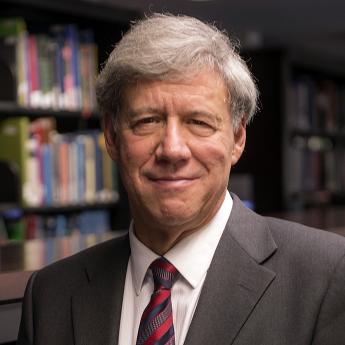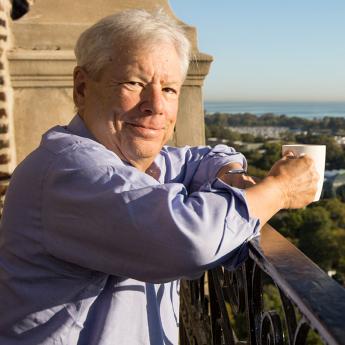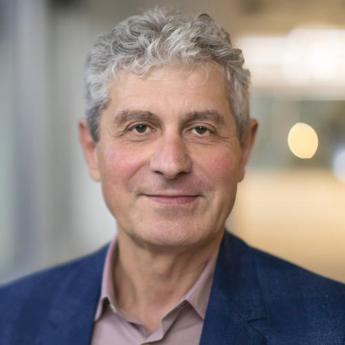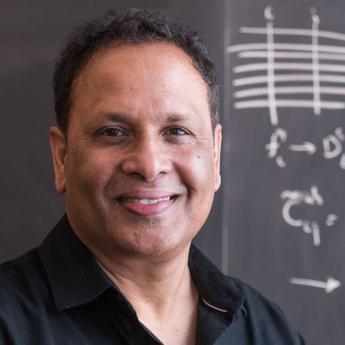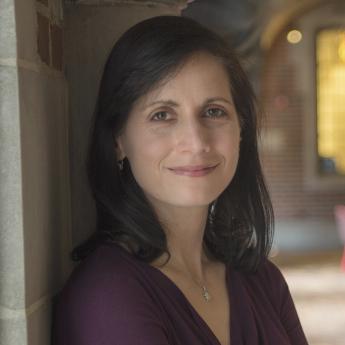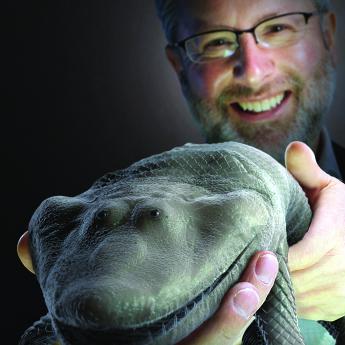Show Notes
Almost a century ago, the origins of sleep science research began at the University of Chicago with the opening of the world's first sleep laboratory. Since then, sleep science has evolved into a multi-disciplinary field — with scientists focusing on diagnosing the causes of sleep disorders, to how sleep affects our metabolic health, and improving methods for good sleep hygiene. But at the core of sleep science, one fundamental question remains: Why do we sleep?
In our special series, The Day Tomorrow Began, we speak with two of the world's leading sleep researchers: Assoc. Prof. Esra Tasali, director of the UChicago Sleep Center; and Prof. Emmanuel Mignot, director of the Stanford Center for Narcolepsy.
Subscribe to Big Brains on Apple Podcasts, Stitcher and Spotify.
(Episode published January 19, 2023)
Subscribe to the Big Brains newsletter.
Please rate and leave a review for the Big Brains podcast.
Related:
- Learn more about sleep research at UChicago
- What is sleep's effect on our health?
- The Day Tomorrow Began homepage
- Getting more sleep reduces caloric intake, a game changer for weight loss programs—UChicago Medicine
Transcript:
Paul Rand: Big Brains is supported by the University of Chicago Graham School. We open the doors of UChicago to learners everywhere. Experience the university’s distinctive approach to inquiry through our online and in-person courses in the liberal arts, culture, science, society, and more. Learn with eminent instructors and extraordinary peers in small, interactive classes. Autumn registration is open now. Visit graham.uchicago.edu/bigbrains.
Paul Rand: Tomorrow. It’s a word that scientists think a lot about. Tomorrow is where new discoveries will be made and old discoveries might be proven wrong. Tomorrow is a hypothesis, and there is nothing scientists love more, but every tomorrow has a beginning. There is always a day that tomorrow began. On Big Brains, we explain the surprising research that’s reshaping the world around us, but today, we’re going to try something new. In a special series we’re calling The Day Tomorrow Began, we’ll be explaining the historical origins of some of the most important ideas that have reshaped our world and the throughlines that they may carry into our future. Many of those origins happened right here at the University of Chicago.
Paul Rand: From the University of Chicago Podcast Network, this is The Day Tomorrow Began, a special Big Brains series that explores the past, present and future of some groundbreaking and breakthrough discoveries. On this episode, the science of sleep. I’m your host, Paul Rand.
Paul Rand: Every night we all fall under the spell of one of science’s greatest mysteries. It affects every facet of our existence, from our physical and our mental health to our happiness, to our ability to be alert and productive. It may be the most important part of our lives and yet it remains an enigma to scientists. Why do humans sleep?
Emmanuel Mignot: There is a lot of theories about sleep.
Paul Rand: That’s Emanuel Mignot, professor of sleep medicine at Stanford University, where he also directs the Stanford Center for Narcolepsy.
Emmanuel Mignot: Sleep is at the core of so many things that you can go in any direction. You cannot be bored being a sleep researcher.
Paul Rand: Much like our dreams, sleep is a maze with many fascinating corners.
Esra Tasali: My view is that we are still answering that fundamental question of why.
Paul Rand: That’s Esra Tasali, Associate Professor of Medicine at the University of Chicago, where she also directs the UChicago Sleep Center.
Esra Tasali: Sleep is, to me, inextricably linked to human biology and human existence.
Paul Rand: Today, a lot of research focuses on our problems with sleep and how we could sleep better. This is what Tasali’s and Mignot’s work is all about, but it’s all built on discoveries made in the earliest days, or nights, of sleep research.
Emmanuel Mignot: When I started to study sleep, of course I knew that all the story, the beginning of sleep research, happened in Chicago.
Paul Rand: And the nights that sleep research began happened at the University of Chicago starting in 1925.
Emmanuel Mignot: It was kind of a house where they were doing all these experiments.
Paul Rand: A young scholar named Nathaniel Kleitman had just arrived on campus with a mission.
Nathaniel Kleitman: Well, I was interested in the state of consciousness and how it operates in a human being. I thought if we know something about the state of unconsciousness, not anesthesia but normal unconsciousness, which is sleep, we may be able to derive an opinion as to what makes the conscious brain operate or how it operates.
Paul Rand: But at the time, most scientists thought sleep was kind of a snooze.
Esra Tasali: Before that, it was thought that sleep was a passive state, or just absence of wakefulness.
Emmanuel Mignot: But at the time where Kleitman and so forth were doing this experiment, it was not clear at all.
Nathaniel Kleitman: I told the head of the department, the chairman, that I was interested in sleep. He said, “I’m interested too. Go ahead and do whatever you want to, but nobody’s going to guide you or tell you what to do.”
Paul Rand: Kleitman established the world’s first sleep laboratory, where he and his students built measuring devices to study people in their sleep. Kleitman was so intrigued with sleep that he even experimented on himself. In 1938, he and his graduate student, Bruce Richardson, spent more than a month 150 feet underground in Mammoth Cave in Kentucky.
Tape: Two Chicago University experts, who in the service of science have been living in the depths of Mother Earth for more than a month, end their test.
Paul Rand: Without having any external cues about whether it was day or night, Kleitman stayed awake for 180 consecutive hours.
Nathaniel Kleitman: Mr. Richardson and I have now been in the Mammoth Cave a little over four weeks. We have come here to make observations in the physiology of sleep, a part of a study that has been going on at the University of Chicago since 1922.
Paul Rand: They were testing the question, do humans have a biological clock?
Tape: Bruce Richardson on the bunk and Dr. Nathaniel Kleitman have been studying the cycle of sleep to see if man without daylight can abandon the seven-day week. The recorder indicates Richardson sleeps and wakes regardless of the 24-hour period while Dr. Kleitman is bound by previous habits.
Esra Tasali: When you’re in a cave with no exposure to light, allows the body to the so-called free running state from those environmental stimuli. You’re at the mercy of your endogenous rhythm.
Tape: Into the underground wonderland of Mammoth Cave goes a party to welcome the men of science back to the outside world. Well, if the experiment helps us to sleep better these hot nights, we vote for science.
Paul Rand: Kleitman and Richardson became the first to demonstrate that humans have an internal clock, also known as circadian rhythm. It regulates our sleep-wake cycle and repeats roughly every 24 hours.
Esra Tasali: The circadian system, the timing of our sleep, our endogenous circadian system regulates our bodily functions together, impacts hormonal levels, how we metabolize food, and how our metabolism is regulated.
Paul Rand: Although this was a massive breakthrough, it wasn’t even the one that has gained him the title the father of modern sleep. That came from an even bigger discovery.
Nathaniel Kleitman: Well, we’re looking for exactly what I’m talking about, for any evidence of different types of brain activity.
Esra Tasali: At that time, the sleep staging, recognition of different kinds of sleep, began to emerge. Kleitman made this landmark discovery about a new sleep state, the dream sleep state.
Emmanuel Mignot: They realized that there was this eye movements that were occurring and that people were in a completely different state.
Paul Rand: What Kleitman and his then student, Eugene Aserinsky, discovered was a new stage of sleep, rapid eye movement, also known as REM sleep.
Emmanuel Mignot: It was an incredible discovery to realize that during sleep, even so people could be asleep, the brain could be as active as you are awake in certain period of time when you’re dreaming. You expend a lot of calories, your heart rate goes all over. It just doesn’t fit at all with that idea that sleep is for saving calories and restoring your body in certain ways.
Paul Rand: What made the discovery of REM so groundbreaking was just how difficult it was to study. It only makes up about 10% of our nightly sleep.
Nathaniel Kleitman: I’ll tell you, I was given a chance to do what I wanted to do. My hope was fulfilled because I was able to find out about sleep.
Emmanuel Mignot: I do believe it’s really important that it’s the oldest, probably, phylogenetic state of sleep that exists. However, it’s often forgotten because it doesn’t last very long and it’s much harder to study and that it occurs in the early morning when you’re the most tired, so it’s very difficult to study. Then in a lot of animals, REM sleep only lasts for like 10 seconds. REM sleep is a very primitive state of rest that comes from probably the most primitive forms of life. It still remains a bit of a mystery why we need REM sleep.
Paul Rand: In the 1950s, another ambitious medical student named William Dement joined the University of Chicago to work with Kleitman and Aserinsky.
Paul Rand: In the sleep lab, they observed patients sleeping by recording the motion of their eyes and the electrical activity of their brains. This technique that Dement developed was called polysomnography. The analog results would be printed on these massive sheets of paper.
Tape: By this time, wow, in that moment, you go from wake to sleep, you go from seeing to being blind, you go from hearing to being deaf, I think is the most remarkable change in the entire neurobehavioral repertoire of human beings.
Esra Tasali: This discovery, this turning point, led to a more clinical and basic science research, increasing recognition of sleep disorders, and to our greater understanding of some of the pathophysiology, and eventually led to development of effective treatments for some of these conditions.
Paul Rand: But this era of sleep science wouldn’t have been complete without another key researcher, Allan Rechtschaffen, who joined the University of Chicago in 1957 and went on to direct the sleep research laboratory for more than 40 years.
Emmanuel Mignot: You are always influenced by people who are good scientists. When I started to study sleep, of course I knew that all the story, the beginning of sleep research, happened in Chicago. I really wanted to see where REM sleep had been discovered. I went there, wanted to go in, but it was closed, it was a weekend. I went in the back and then I sneaked him and then I found Al Rechtschaffen, but thank God they didn’t call the police.
Esra Tasali: He was a giant and brilliant sleep scientist. He basically devoted his career to understanding this one fundamental question, why do we sleep?
Paul Rand: Back to the big question, why do we sleep? Well, in 1983, Rechtschaffen published a landmark finding, that sleep is essential for survival, and not just for humans, but for rats and other mammals too.
Emmanuel Mignot: Well, I think his biggest breakthrough is to have really establish how essential it is to survival to sleep, that if you don’t sleep you develop all kind of very complex metabolic immune disturbances, that your whole body breaks down. I think that has been one of his major contribution.
Esra Tasali: His experimental research in animals has shown that sleep actually serves a vital function for our survival. His experimental rats that he studied, who were continuously sleep deprived, not only suffered severe health effects, but died after about two to three weeks of sleep deprivation. This was really a turning point to show the critical importance of sleep to good health in life.
Esra Tasali: I was lucky enough to meet him at the end of my fellowship in 2001 when I was given the Allan Rechtschaffen Award for Excellence as a fellow. At the time, the sleep fellows, the first thing they were given to read was the scoring system, the standardized scoring system that he developed, which still forms the basis of our scoring manuals used worldwide today. He signed my scoring manual and finally said to me before I leave, “Good luck.” Yes, I have great memories of him, yeah.
Paul Rand: Rechtschaffen also shaped our understanding of sleep disorders today. Along with William Dement, he identified and defined the world’s first true sleep disorder, narcolepsy.
Emmanuel Mignot: Even in narcolepsy, which is my baby, the problem with narcolepsy is really that they can’t stay awake. Basically, all day long they’re just very tired, kind of a fog, and then they have to take naps, they would be talking on the phone and they would fall asleep. They have a lot of problems staying awake. Then when they sleep they feel better, but it only lasts for like one hour and then after it restarts.
Emmanuel Mignot: Narcolepsy was a mystery since the 19th century. People have always felt that there was something to be found. When you just read the literature, people knew that it was a real disease entity. He was the first to really report patients with narcolepsy were going straight into REM sleep, together with Dement, because of course, after the discovery of REM sleep, everyone though, oh my God, narcolepsy, it’s clear that it’s a REM sleep problem. He was one of the first to actually publish a case series where he was really showing that a patient with narcolepsy goes straight from being awake to REM sleep. I cite that paper very often.
Paul Rand: The discovery of narcolepsy paved the way for diagnosing all kinds of sleep disorders. Today, there are more than 80 recognized sleep disorders, but up until last year, scientists had no idea what caused narcolepsy. That’s until Dr. Emanuel Mignot made a breakthrough discovery. That story and the future of sleep research after the break.
Paul Rand: Big Brains is supported by the University of Chicago Graham School. We open the doors of UChicago to learners everywhere. Experience the university’s distinctive approach to inquiry through our online and in-person courses in the liberal arts, culture, science, society, and more. Learn with eminent instructors and extraordinary peers in small, interactive classes. Autumn registration is open now. Visit graham.uchicago.edu/bigbrains.
Paul Rand: Emmanuel Mignot was always fascinated with the science of sleep, but he stumbled into studying narcolepsy accidentally.
Emmanuel Mignot: It’s partially by chance and partially by passion. I was in France and I did my MD PhD in pharmacology, and I discovered a drug company that was developing a drug for narcolepsy that was called modafinil, which is still prescribed a lot. I convinced a French government to send me to Stanford to study this drug called modafinil with the ideas that maybe it would be developed in the US and it would benefit France. Indeed, modafinil was bought by Cephalon and then was developed in the US and became a very commercial success. I was sent to Stanford to really study this drug in narcolepsy dogs.
Paul Rand: These weren’t your average cute and snugly sleepy dogs. These were dogs who really couldn’t stay awake.
Emmanuel Mignot: Narcolepsy is very scary, but very quickly I realized that, oh my God, it’s so fascinating, this disease. If we could find a cause, maybe we would learn something completely new about sleep.
Paul Rand: Mignot had a hypothesis. Perhaps narcolepsy was genetic, maybe it was passed down from dogs to their puppies and to their puppies and their puppies.
Emmanuel Mignot: You can imagine that you can track the families of dogs with narcolepsy. I used a technique that’s called linkage analysis to try to find a gene based on these large families of dogs and also trying to find dogs, even dobermans or Labradors, in breeders and so forth. I would travel and take blood sample until I found a gene that caused a disorder in dogs. It took 10 years. Many people thought I was crazy because nobody had ever isolated the genes this way in dogs, but if not dogs, it had never been done. To do this well, you need a map of the dog genome and that didn’t even exist. I had to build everything from scratch. It is true, honestly, I was crazy, but sometimes that’s what you have to do to get the solution.
Paul Rand: What made Mignot’s experiments such an undertaking was isolating that one gene.
Emmanuel Mignot: I would’ve known that it would take 10 years, I’m not sure I would’ve done it.
Paul Rand: Mignot discovered that narcolepsy was purely genetic in dogs, but not in humans. There was a different cause.
Emmanuel Mignot: What attracted me about the dogs is that I knew that there were one single change in the DNA molecules that was sufficient to produce all the symptoms of narcolepsy. I thought that by finding the gene it will lead me to the human disease, even though it was not genetic in humans, and it did.
Emmanuel Mignot: Once I found the cause in narcolepsy, it was a receptor for a molecule called orexin. In the brain you have a lot of chemicals and usually they just release by neurons and then they act on another neuron through something that’s called a receptor. A receptor and a molecule is a bit like a key and a lock. You can imagine in the brain there is all these keys that are floating around that are neurotransmitters and then they find a lock, and then they go inside the lock, they turn it and they activate the other cells, and then they transmit the signal.
Emmanuel Mignot: Here, in the dog, it was a mutation in receptors, so in the lock, the lock was broken. But then in humans, very quickly when we found that, we found that it was a key that was missing, the orexin, as opposed to the orexin receptor. That’s why it was not genetic in human. In fact, we discovered it was a autoimmune disease, this really is the immune systems that attacks the brain cells that produce this chemical. Once the cells are destroyed, you have narcolepsy.
Paul Rand: Mignot’s discovery not only allows us to understand the cause of narcolepsy, but may even help us cure it.
Emmanuel Mignot: From the beginning, I was super excited because I knew that you could change maybe the life of these patients by replacing the chemicals. The problem is that the molecule is only produced in the brain, this orexin is only produced in the brain. If we inject it in the blood, it just cannot go into the brain. The orexin itself, that doesn’t cross the blood-brain barrier. Now, there are drug companies that have developed drugs that can actually mimic the effect of orexin, a little bit like key in the lock. They have created this little molecules that are like a mini key that still can activate the receptor, but they are small enough to go into the brain. We have already tried these molecules recently in a few patients with narcolepsy and it’s amazing. It completely transforms their life.
Paul Rand: You may be wondering, what about people who aren’t narcoleptic but still feel drowsy and tired all the time?
Emmanuel Mignot: It’s also probably going to help a lot of other people. Right now, if you want to stay awake, you have to take amphetamines, whereas this drug seems to work completely differently and keeps you awake. People who depressed, people who are tired for reasons that we don’t know, all these patients are likely to be helped by these new drugs.
Paul Rand: These drugs are still going through clinical trials, but the results are promising. Mignot’s accomplishments for discovering the cause of narcolepsy led him to win the 2023 Breakthrough Prize in Life Sciences. He hopes this will pave the way for our understanding of other idiopathic sleep disorders, what causes them and is it possible to cure them.
Esra Tasali: The classification of sleep disorders or our understanding of them are evolving as we discover how many are even intertwined with each other. We’re discovering it’s a multifaceted situation, many are linked to each other. Two most common ones are sleep apnea and insomnia. Now we know that in some patients, particularly in women, who may present with insomnia, the actual problem is sleep apnea.
Paul Rand: The sleep disorder that Dr. Tasali specializes in is sleep apnea, one of the most common sleep disorders worldwide.
Esra Tasali: Just to give you some statistics, sleep apnea is really an epidemic public health problem. It affects 54 million of US adults and one billion people world wide.
Paul Rand: Sleep apnea is a sleep disorder in which your breathing stops and starts during the night. Some of the symptoms can be quite common, like loud snoring or feeling overtired during the day.
Esra Tasali: It is one of those situations where there’s a cure. If the problem is the enlarged tonsils, we can take the tonsils out with a simple surgery and sleep apnea is cured. Sufficient weight loss can cure sleep apnea. The other example is how we completely eliminate sleep apnea by using the machine called CPAP machine, positive airway pressure machine, which was discovered actually about 40 years ago and still the best cure for sleep apnea when used properly at night, all night.
Esra Tasali: Mechanistically, our research for sleep apnea has been around the metabolic implications of sleep apnea, how it’s related to diabetes, pre-diabetes, and insulin resistance. There is the confounding factor of obesity there, but what we are finding more and more is that sleep apnea, independent of the excess weight, can alter body’s metabolism in such a way that people will be at risk for diabetes, will be at risk for cardiovascular disease. It can impact their heart rate during the day, it has a carryover effect to the next day with a higher what they call resting heart rate, which is a marker for increased cardiovascular mortality and morbidity. Some of our research is now, ongoing research, is looking at the mitochondrial level,.
Paul Rand: Whether you have a sleep disorder or not. Decades of research have made it abundantly clear that getting enough sleep is vital to our overall health. We don’t just need sleep to feel rested and restored the next day, but we need it to be physically healthy too.
Esra Tasali: In 2004, our laboratory showed that sleep deprivation leads to increased appetite in healthy individuals, experimental sleep deprivation leads to insulin resistance, the hormone that puts your blood sugar down. Our study was the first clinical study linking sleep restriction to an alteration of a molecular metabolic pathway. What we knew from laboratory studies is that sleep deprivation stimulates appetite, increases cravings for sugar and junk food, and increases risk for weight gain. But what we didn't know if we can do anything about it in real life. Therefore, we conducted this recent study in people's usual environment. We took 80 people who were overweight. They habitually slept for less than six and a half hours a night below the recommended 8 hours. We did not give them any dietary or exercise advice. We used a personalized sleep hygiene counseling session to increase the amount of time they slept. And interestingly, extending sleep may not be as hard as people think. Small changes in sleep behaviors around bedtime or in the morning was helpful and made a huge difference in the amount of sleep duration they got. And one of the most effective intervention in that study was limiting the electronic use before bedtime. What we found was that when getting sufficient sleep, they ate on average by about 270 calories less. So this has huge implications. This this study published in JAMA Internal Medicine, is actually a culmination of more than 15 years of research that is done at the University of Chicago into the connections between sleep, weight and energy regulation.
Paul Rand: The total number of hours you sleep each night isn’t the only factor. If you’ve ever taken a red eye or had to spend a night in an airport, you know what a difference it makes when you’re not in a comfy bed. The quality of your sleep truly matters.
Esra Tasali: We’ve also shown in 2008 that not only sleep duration, but sleep quality matters. We basically sent acoustic sounds to healthy subjects’ room and disrupted the so-called deep sleep and fragmented their sleep without impacting the sleep duration. What we saw after a couple of nights of slow wave sleep, deep sleep deprivation, that the subject also showed signs of insulin resistance in the morning. Both sleep duration and quality matters.
Paul Rand: By this point, you’re probably wondering, how much sleep do I need? Is there a magic number? Well, we ask the sleep experts.
Esra Tasali: That’s interesting you’re asking this question. I was part of the committee that recommended healthy sleep duration for adults. All we did is we reviewed the literature for about three months, this was our task, and then we gathered together in a hotel for two days in a row. The goal was to come up with that magic number and we couldn’t come up with that magic number for a recommended sleep duration. What we ended up saying is that adults need, based on the evidence, anywhere between seven to nine hours of sleep, young children would need at least 10 hours of sleep, teenagers need at least nine hours. My view on this is that sleep need is variable from person to person and we have to acknowledge that.
Emmanuel Mignot: We know that a lot of people who don’t need sleep, they are still sleep deprived. What I mean by that is that if you tell them to lay down, they fall asleep like this. It’s not like they’re rested, it’s just that they don’t care. In addition to that, there is also people who need more or less sleep to be rested. We don’t really understand why, but that’s definitely a fact. There’s probably genetic differences, maybe you can train yourself to need less sleep. We don’t really know, there is definitely a lot to study.
Esra Tasali: I think that our lifestyles have become more and more fast paced. We are overstimulated, over-scheduling our days, and these become stressors at the expense of having poor sleep patterns, I think. But I think that one of the issues is we value quantity over quality and sleep is viewed as waste of time and an impediment to being more productive. I would argue the opposite. I’m a passionate sleep researcher and I can give an anecdote from one of our sleep extension study subjects, or a couple of them, who thanked me after the study. They said they would’ve never thought that after getting sufficient sleep they would accomplish what they planned for the day in a shorter amount of time, more efficiently, because they had more energy, because they were feeling more alert and because they were in a better mood. I think that it is not easy, but it is possible. We should prioritize sleep.
Paul Rand: Nowadays, you can find all kinds of fancy gadgets and devices that promise to improve your sleep. These interventions could one day be the future of sleep medicine, but Dr. Tasali says there are also simple interventions to improve our sleep hygiene.
Esra Tasali: Keeping regular bedtimes, regular wake-up times, decreasing stimulating activities close to bedtime, such as not being on your phone or texting or limiting caffeine intake. Most people think it’s just the nighttime, but any caffeine that you may take after 4:00, in the mid-afternoon, may impact your sleep. Limiting light exposure at night and getting a good sleep routine, I would say. It starts at an early age.
Paul Rand: The inevitable truth is that sleep deprivation will catch up to you eventually. Scientists are still learning about the connection between sleep loss and disease, like dementia for example.
Esra Tasali: One of the sleep functions that we are discovering is its important role in clearing the metabolic waste products that accumulate. In dementia, for example, beta amyloid is cleared out. If you want to be healthy and not walk around with a dirty brain, so to speak, you need sleep.
Emmanuel Mignot: I’m pretty convinced that in the future we’re going to continue to discover more and more disease where the immune system is very important. For example, now it has led me to start to study how the immune system could be important in protecting against Parkinson’s disease and Alzheimer. What I like about sleep medicine, as a doctor, is that of course I’m a scientist so I love the discovery process, which I just get excited about finding things, but also, I like to treat patients with sleep disorders because you can do something.
Esra Tasali: The initial discoveries in 1989 by Rechtschaffen in animals led us to today’s research. We learned, most importantly, that sleep is not just for our brains, but for the rest of our body. That’s what University of Chicago’s contribution has been. Sleep also impacts peripheral functions, bodily functions, metabolism. We are no longer a simple sleep laboratory, our sleep center has several missions. We want to provide excellence in clinical care to prevent, diagnose, treat sleep disorders. We want to keep our curiosity and rigor in research to lead us to new scientific discoveries, we want to train next generation sleep doctors and scientists, and most importantly, we want to educate the public about healthy sleep habits. Even today, I’m still excited to be like a curious child, to be part of the next discovery about sleep.
Matt Hodapp: Big Brains is a production of the University of Chicago Podcast Network. If you like what you heard, please leave us a rating and review. The show is hosted by Paul M. Rand and produced by me, Matt Hodapp, and Lea Ceasrine. Thanks for listening.
Episode List
SCOTUS Nears Unimaginable Era with Geoffrey Stone (Ep. 8)
Legal scholar Geoffrey Stone discusses why we are on the verge of an unimaginable era for the Supreme Court, the forgotten history of Roe v. Wade and free expression on college campuses.
Economist’s Journey to the Nobel with Richard Thaler (Ep. 7)
Richard Thaler discusses how a bowl of cashews inspired his early research, how he missed a 4 a.m. Nobel wakeup call from Sweden, and what it was like to act in a movie alongside Selena Gomez.
Future of Energy Innovation with Michael Polsky (Ep. 6)
In this alumni edition of Big Brains, Michael Polsky discusses his early days in the energy field, his current project to build one of the largest wind farms in the world and why he believes in the power of innovation.
The Expanding Universe with Wendy Freedman (Ep. 5)
Prof. Wendy Freedman discusses her research on measuring the age of the universe, her leadership of the Giant Magellan Telescope and the search for life outside our solar system.
Nature’s Design Secrets with Rama Ranganathan (Ep. 4)
Prof. Rama Ranganathan shares his pioneering research on evolutionary physics, and explains why he believes biology is at a similar point today as engineering was two centuries ago during the Industrial Revolution.
Mind of a Virtuoso Composer with Augusta Read Thomas (Ep. 3)
Prof. Augusta Read Thomas gives a glimpse into the creative process of a world-class composer, discusses the state of classical music today and how she helps train the next generation of composers.
Myths of U.S. Health Care with Katherine Baicker (Ep. 2)
Prof. Katherine Baicker discusses research on the true costs and benefits of expanding health care, dispelling a number of myths, and provides insights into how to improve health care for all.
Discovering the Missing Link with Neil Shubin (Ep. 1)
Prof. Neil Shubin discusses his discovery of Tiktaalik roseae, the 375-million-year-old fossil that was a missing link between sea and land animals—and what it meant for the understanding of human evolution and how it has impacted the future of genetic research.


